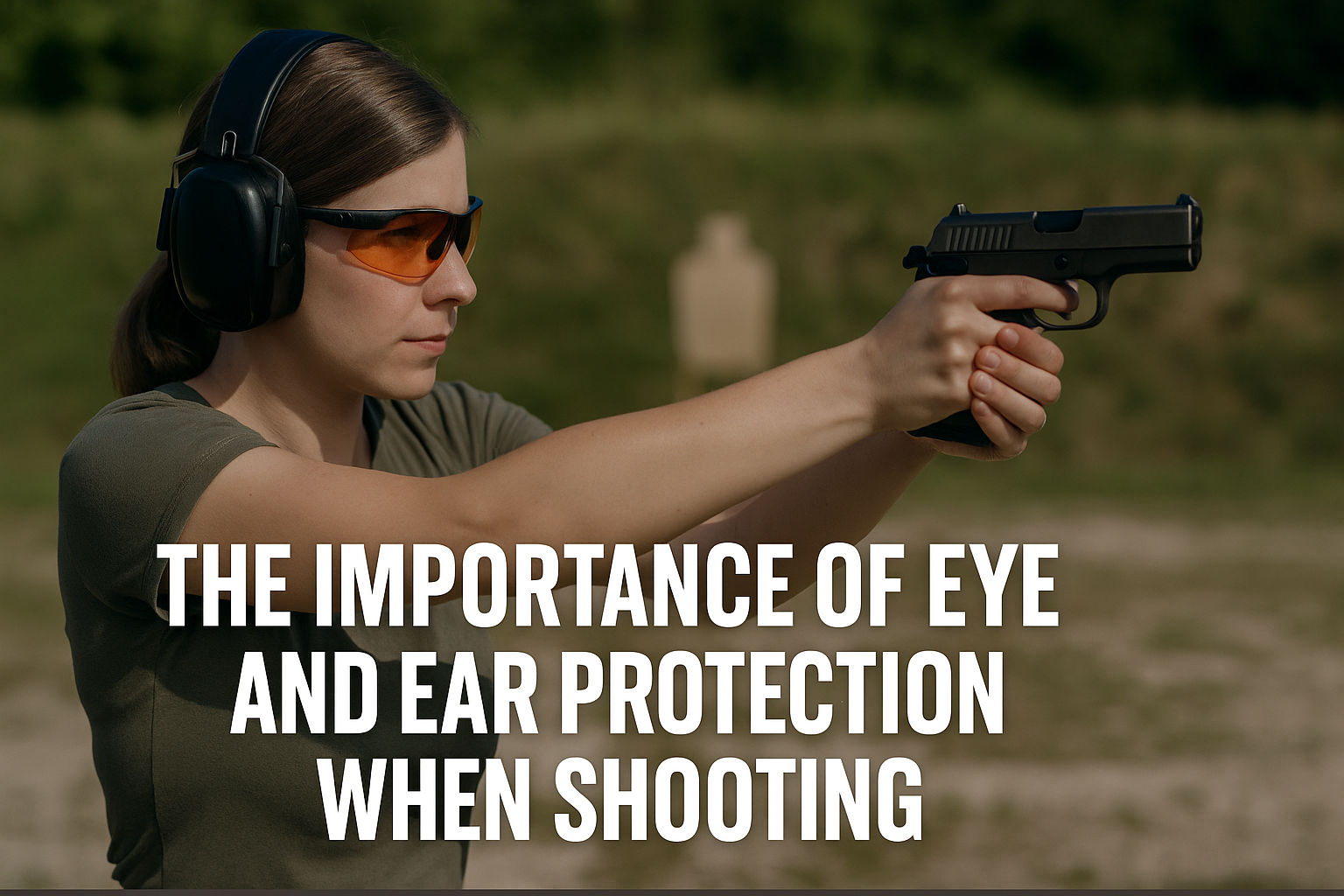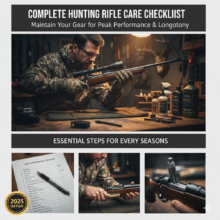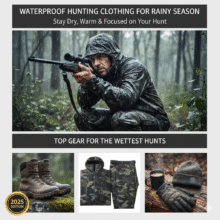The Importance of Eye and Ear Protection When Shooting

Whether you are a seasoned hunter, a recreational shooter, or a first-time visitor at the range, one thing should always remain a top priority: safety. Firearms are powerful tools, and while they offer sport, protection, and recreation, they also produce significant risks especially to the eyes and ears. Eye and ear protection is not optional; it is essential.
In fact, according to the National Institute for Occupational Safety and Health (NIOSH), thousands of shooting-related injuries occur every year due to lack of proper safety gear. Many of these incidents could have been prevented with high-quality protective equipment. This article explores the importance of eye and ear protection when shooting, the potential risks of neglecting them, types of protective gear available, and tips for choosing the right equipment.
Table of Contents
- Why Eye Protection Is Essential When Shooting
- Why Ear Protection Is Just as Important
- Types of Eye Protection for Shooting
- Types of Ear Protection for Shooting
- Double Protection: The Best Practice for Shooters
- Choosing the Right Protective Gear
- Common Myths About Eye and Ear Protection
- The Cost of Neglecting Protection
- Tips for Maintaining Protective Gear
- Eye and Ear Protection for Different Shooting Scenarios
- Conclusion
Why Eye Protection Is Essential When Shooting
The Risks to Your Eyes
Firearms discharge bullets at incredibly high speeds, but the projectile itself is not the only risk. Hot gases, unburned gunpowder, shell casings, and small metal fragments can ricochet or blow back toward the shooter’s face. Even if you are extremely cautious, environmental hazards—like dust, dirt, or flying debris—can easily cause irritation or long-term injury to the eyes.
Without proper eye protection, shooters risk:
- Foreign object injury: Brass casings can eject unpredictably.
- Powder burns: Hot gases and unburned gunpowder can cause painful burns.
- Ricochet hazards: Bullets or fragments bouncing off surfaces may strike the eye.
- UV damage: Outdoor shooting exposes the eyes to harmful ultraviolet rays.
- Permanent blindness: Severe trauma could result in irreversible loss of vision.
Real-World Statistics
The American Academy of Ophthalmology reports that about 90% of all eye injuries could be prevented by protective eyewear. Shooting sports consistently rank among the top recreational activities where eye protection is critical. Even a split-second lapse could cause lifelong consequences.
Why Ear Protection Is Just as Important
Understanding the Noise Levels of Firearms
Gunshots are extremely loud—typically ranging between 140 to 175 decibels (dB) depending on the firearm. To put that into perspective:
- Normal conversation: 60 dB
- Lawnmower: 90 dB
- Rock concert: 110 dB
- Pain threshold: ~120 dB
- Gunshot: up to 175 dB
The threshold for immediate, permanent hearing damage is 140 dB. That means every single gunshot has the potential to cause instant harm.
Types of Hearing Damage From Shooting
- Temporary Threshold Shift (TTS): Ringing in the ears after shooting, also known as tinnitus.
- Permanent Threshold Shift (PTS): Irreversible hearing loss caused by repeated exposure.
- Acoustic trauma: Sudden, severe damage from a single loud noise, leading to instant hearing impairment.
Many shooters believe that because hearing loss happens gradually, it is not a pressing concern. However, studies show that even one unprotected gunshot can cause permanent hearing loss.
Types of Eye Protection for Shooting
1. Shooting Glasses
Specialized shooting glasses are designed with impact-resistant lenses and durable frames. Features to look for include:
- Polycarbonate lenses (stronger than standard plastic or glass)
- Wraparound design for full peripheral protection
- Anti-fog coatings to maintain clear vision
- Adjustable nose pieces for comfort during long sessions
2. Ballistic Eyewear
For tactical shooters, military personnel, or competitive marksmen, ballistic eyewear offers enhanced durability tested against military standards. These lenses can withstand extreme impact forces.
3. Prescription Safety Glasses
For shooters who need corrective lenses, prescription shooting glasses combine vision correction with ballistic safety standards. This eliminates the need to wear glasses under protective eyewear, improving comfort and clarity.
4. Lens Color Options
Different lens tints can enhance performance in various environments:
- Yellow/Amber: Improves contrast in low light.
- Gray/Smoke: Reduces glare on bright days.
- Clear: Best for indoor ranges.
- Polarized: Cuts glare from reflective surfaces outdoors.
Types of Ear Protection for Shooting
1. Earplugs
Earplugs fit directly inside the ear canal, reducing noise exposure by 20–30 dB. They are affordable, portable, and effective when inserted correctly. Options include:
- Foam earplugs: Expand inside the ear canal for a secure fit.
- Custom-molded earplugs: Personalized to the shooter’s ear for maximum comfort.
- Filtered earplugs: Reduce harmful noise while allowing conversation.
2. Earmuffs
Earmuffs cover the entire ear with padded cups that block sound. They typically reduce noise by 20–30 dB. Advantages include:
- Easy to wear and remove
- Suitable for all head sizes
- Can be combined with earplugs for double protection
3. Electronic Hearing Protection
Electronic earmuffs or earplugs use built-in microphones and speakers to block harmful gunshot noise while still amplifying safe sounds like conversation or range commands. This makes them especially useful for group shooting scenarios.
Double Protection: The Best Practice for Shooters
Experts recommend using both earplugs and earmuffs simultaneously when shooting high-caliber firearms or at indoor ranges. Double protection can reduce noise exposure by up to 35–40 dB, offering maximum safety.
Choosing the Right Protective Gear
For Eye Protection:
- Look for ANSI Z87.1 certification, which ensures eyewear meets industry safety standards.
- Ensure the frame fits snugly without slipping during recoil.
- Choose interchangeable lenses if you shoot in various environments.
For Ear Protection:
- Consider the Noise Reduction Rating (NRR); higher numbers indicate more protection.
- If you shoot indoors or with rifles/shotguns, electronic earmuffs with high NRR are ideal.
- For maximum safety, use earmuffs + earplugs together.
Common Myths About Eye and Ear Protection
Myth 1: “I’m outdoors, so I don’t need hearing protection.”
False. Noise damage is not limited to enclosed spaces. Outdoor shooting may feel less intense, but the decibel level remains harmful.
Myth 2: “My regular sunglasses will protect my eyes.”
Incorrect. Standard sunglasses are not impact-resistant and can shatter upon impact, causing even more damage.
Myth 3: “I’ve been shooting for years without protection, and I’m fine.”
Hearing damage often develops gradually. Many shooters don’t notice until significant loss has occurred.
The Cost of Neglecting Protection
- Medical costs: Eye surgeries, hearing aids, and treatments are expensive.
- Quality of life: Permanent blindness or deafness drastically affects daily living.
- Safety risks: Hearing loss may prevent shooters from hearing commands or nearby warnings.
A pair of shooting glasses might cost $20–$100, and high-quality earmuffs range from $30–$200. These small investments pale in comparison to the lifelong consequences of neglecting protection.
Tips for Maintaining Protective Gear
- Clean lenses regularly with microfiber cloths to prevent scratches.
- Check earmuff seals for wear and replace when necessary.
- Store gear in protective cases to extend their lifespan.
- Replace foam earplugs after each use for hygiene and effectiveness.
- Test electronic earmuffs before shooting to ensure batteries are working.
Eye and Ear Protection for Different Shooting Scenarios
Indoor Ranges
- Always use double hearing protection due to echo and confined spaces.
- Clear or lightly tinted lenses are best for visibility.
Outdoor Ranges
- Polarized or tinted lenses reduce glare.
- Earmuffs with electronic amplification help maintain awareness of surroundings.
Hunting
- Lightweight glasses with amber lenses help in wooded areas.
- Electronic earplugs or earmuffs amplify natural sounds (like footsteps) while blocking gunshots.
Tactical and Competitive Shooting
- Ballistic eyewear is mandatory.
- High-end electronic hearing protection ensures you don’t miss range commands.
Conclusion
The importance of eye and ear protection when shooting cannot be overstated. Every firearm discharge poses risks, and neglecting safety gear can result in irreversible damage within seconds. Fortunately, protective equipment is widely available, affordable, and designed for comfort and performance.
Investing in the right protective gear ensures that your shooting experience remains safe, enjoyable, and sustainable for years to come. Whether you’re at the range, in the field, or competing professionally, remember this golden rule: protect your eyes and ears every single time you shoot.







